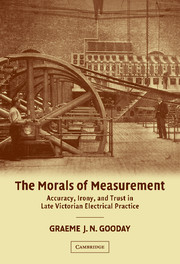Book contents
- Frontmatter
- Contents
- List of illustrations
- Abbreviations
- Preface
- 1 Moralizing Measurement: (Dis) Trust in People, Instruments, and Techniques
- 2 Meanings of Measurement and Accounts of Accuracy
- 3 Mercurial Trust and Resistive Measures: Rethinking the ‘Metals Controversy’, 1860–1894
- 4 Reading Technologies: Trust, the Embodied Instrument-User and the Visualization of Current Measurement
- 5 Coupled Problems of Self-Induction: The Unparalleled and the Unmeasurable in Alternating-Current Technology
- 6 Measurement at a Distance: Fairness, Trustworthiness, and Gender in Reading the Domestic Electrical Meter
- Conclusion
- Index
5 - Coupled Problems of Self-Induction: The Unparalleled and the Unmeasurable in Alternating-Current Technology
Published online by Cambridge University Press: 23 November 2009
- Frontmatter
- Contents
- List of illustrations
- Abbreviations
- Preface
- 1 Moralizing Measurement: (Dis) Trust in People, Instruments, and Techniques
- 2 Meanings of Measurement and Accounts of Accuracy
- 3 Mercurial Trust and Resistive Measures: Rethinking the ‘Metals Controversy’, 1860–1894
- 4 Reading Technologies: Trust, the Embodied Instrument-User and the Visualization of Current Measurement
- 5 Coupled Problems of Self-Induction: The Unparalleled and the Unmeasurable in Alternating-Current Technology
- 6 Measurement at a Distance: Fairness, Trustworthiness, and Gender in Reading the Domestic Electrical Meter
- Conclusion
- Index
Summary
The introduction of powerful alternate current machines by Siemens, Gordon, Ferranti, and others, is likely … to have a salutary effect in educating those so-called practical electricians whose ideas do not easily rise above ohms and volts. It has long been known that when the changes are sufficiently rapid, the phenomena are governed much more by induction, or electric inertia, than by mere resistance. On this principle much may be explained that would otherwise seem paradoxical.
Lord Rayleigh, Presidential Address to the BAAS, Montreal, 1884[T]he secohmmeter does not measure all that can be measured. That is true.
Ayrton and Perry, Discussion at the STEE, 1887Preceding chapters discussed how the industries of submarine telegraphy and electric lighting prompted concern for measuring electrical properties and were the main audiences for new technologies that measured electrical resistance and direct current, respectively. This chapter extends this theme to consider the emergence of self-induction as an important but troublesome parameter in the technology of ac generation developed in the late 1880s. My main focus is the fate of the ‘secohmmeter’, an instrument designed by William Ayrton and John Perry to measure self-induction. Hitherto practitioners had often treated self-induction as a source of major errors in measurements of electrical resistance. For example, in 1881 Lord Rayleigh diagnosed that neglect of self-inductive effects in the operation of ‘whirling-coil’ apparatus had lead to an error of more than 1% in the BAAS Electrical Standards Committee's determination of absolute resistance fifteen years earlier (Chapter 3).
Information
- Type
- Chapter
- Information
- The Morals of MeasurementAccuracy, Irony, and Trust in Late Victorian Electrical Practice, pp. 173 - 218Publisher: Cambridge University PressPrint publication year: 2004
